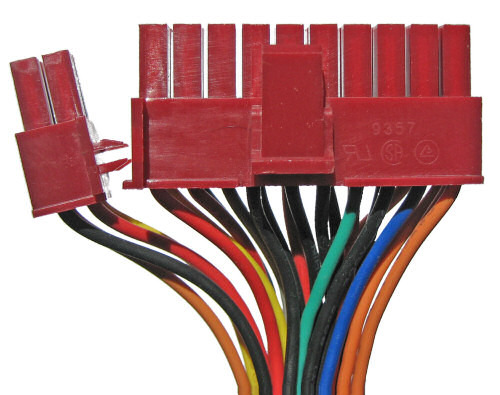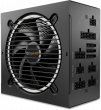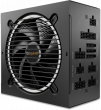Ultra-Quiet ATX PSU 350W, 120mm fan Discontinued | |
Ultra-Quiet ATX PSU 400W, 120mm fan Discontinued | |
Ultra-Quiet ATX PSU 360W, 120mm fan OEM Discontinued | |
| More variations available Show | |
QTechnology Ultra-Quiet ATX PSUs
Our bestselling QTechnology Ultra-Quiet PSUs are the perfect choice for the vast majority of PCs and will give astounding results at a great price! Many professional audio workstation manufacturers are now using these units in their systems. Whether you are building your own studio PC, or you simply want to maintain a quiet home environment, the QTechnology PSUs really do deliver.
Building on the success of their earlier power supplies, QTechnology have made available three ultra quiet large-fan PSUs, rated at 360, 400 and 460 watts. They have an integrated 120 mm fan which provides a similar level of airflow to PSUs equipped with 80mm fans, but because the fan is larger in diameter it spins much more slowly. Therefore it is even quieter!

QTechnology 120mm fan Ultra-Quiet Power Supplies, 360W left (discontinued), 460W right
Instead of the fan being located at the back of the PSU, the 120 mm fan is on the underside (assuming you have a tower system), such that it sits adjacent to the CPU cooler. Because of this, the power supply not only runs quietly, but also assists in reducing the temperature of the processor and the ambient case temperature. Warm air is expelled through the large grille area on the rear of the power supply. These power supplies are exceptionally quiet, even when the loading and therefore temperature of the unit increases.
PLEASE NOTE - It has come to our attention that another company called “Q-Tec” has recently entered the market and is causing confusion by offering low cost PSUs in competition with QTechnology. Please be certain that neither QTechnology nor Quiet PC have any connection whatsoever with Q-Tec. We know several instances of customer being disappointed with the quality and noise level of Q-Tec PSUs only to find out later that the product they had bought was not made by QTechnology. If you are not buying directly from Quiet PC, please make sure you know what you are buying, and if the price seems too good to be true, it probably is! To add further to the confusion, we now find that there is a third company calling themselves Qtech who have started offering pre-built PCs. Again, our position is that we have no association with them.
All QTechnology power supplies come with a full 24 months manufacturers warranty.
Review
Creative Mods.com
I was impressed with how quiet it was and how nice it looked. (Product reviewed: 350W, 120mm fan)
| Specifications | 350W | 360W OEM | 400W |
|---|---|---|---|
| Model Number | QT-03350G Gold | QT-05360G | QT-03400G Gold |
| ATX12V Version | v2.2 | v2.2 | v2.2 |
| 20-pin ATX Connector | Yes | Yes | Yes |
| 24-pin ATX Connector | Yes | Yes | Yes |
| ATX12V (4-pin) support | Yes | Yes | Yes |
| EPS12V (8-pin) support | Yes | No | No |
| PCI-E support (6-pin) | Yes | Yes | Yes |
| Number of floppy drive connectors | 1 | 2 | 1 |
| Number of hard drive connectors | 4 | 4 | 4 |
| Number of SATA power connectors | 4 | 4 | 4 |
| Master power on/off switch | Yes | Yes | Yes |
| Acoustic noise level | 17 - 27 dB(A) | 19 - 32 dB(A) | 19 - 32 dB(A) |
| Mains input voltage selection | Auto-range | 200-240 VAC only | Auto-range |
| Length of motherboard power cable | 50 cm (approx) | 40 cm (approx) | 50 cm (approx) |
| +3.3V maximum output current | 22 A | 22 A | 30 A |
| +5V maximum output current | 21 A | 21 A | 28 A |
| Total +12V maximum output current | 25 A | 25 A | 29 A |
| +12V1 maximum output current | 10 A | 10 A | 14 A |
| +12V2 maximum output current | 15 A | 15 A | 15 A |
| Combined maximum output +3.3V / +5V | 130 W | 130 W | 130 W |
| +5VSB maximum standby current | 2.0 A | 2.0 A | 2.0 A |
| Mains input voltage | 115-230 VAC, 50-60 Hz | 200-240 VAC, 50 | 115-230 VAC, 50-60 Hz |
| Physical dimensions | Standard ATX (86 x 150 x 140 mm) | Standard ATX (86 x 150 x 140 mm) | Standard ATX (86 x 150 x 140 mm) |
| Power conversion efficiency | More than 70% | More than 70% | More than 70% |
| Shipping / storage temperature | -20°C to 60°C | -20°C to 60°C | -20°C to 60°C |
| Operating temperature | 0°C to 50°C | 0°C to 50°C | 0°C to 50°C |
| Remote power on / off | Yes | Yes | Yes |
| Fan speed control | Thermal, maximum speed limited | Thermal, maximum speed limited | Thermal, maximum speed limited |
| Over voltage protection | +3.3V, +5V > 130%, +12V > 140% | +3.3V, +5V > 130%, +12V > 140% | +3.3V, +5V > 130%, +12V > 140% |
| Short circuit protection | Yes, on all outputs | Yes, on all outputs | Yes, on all outputs |
| EMC | CE / CNS / FCC / CISPR22 | CE / CNS / FCC / CISPR22 | CE / CNS / FCC / CISPR22 |
| Hold-up time | 16ms at full load | 16ms at full load | 16ms at full load |
| Monitor pass-through power socket | No | No | No |
| Mean Time Between Failure at 25°C | Over 100,000 hours at 75% load | Over 100,000 hours at 75% load | Over 100,000 hours at 75% load |
| Specifications | 350W | 360W OEM | 400W |
|---|---|---|---|
| Model Number | QT-03350G Gold | QT-05360G | QT-03400G Gold |
| ATX12V Version | v2.2 | ||
| 20-pin ATX Connector | Yes | ||
| 24-pin ATX Connector | Yes | ||
| ATX12V (4-pin) support | Yes | ||
| EPS12V (8-pin) support | Yes | No | |
| PCI-E support (6-pin) | Yes | ||
| Number of floppy drive connectors | 1 | 2 | 1 |
| Number of hard drive connectors | 4 | ||
| Number of SATA power connectors | 4 | ||
| Master power on/off switch | Yes | ||
| Acoustic noise level | 17 - 27 dB(A) | 19 - 32 dB(A) | |
| Mains input voltage selection | Auto-range | 200-240 VAC only | Auto-range |
| Length of motherboard power cable | 50 cm (approx) | 40 cm (approx) | 50 cm (approx) |
| +3.3V maximum output current | 22 A | 30 A | |
| +5V maximum output current | 21 A | 28 A | |
| Total +12V maximum output current | 25 A | 29 A | |
| +12V1 maximum output current | 10 A | 14 A | |
| +12V2 maximum output current | 15 A | ||
| Combined maximum output +3.3V / +5V | 130 W | ||
| +5VSB maximum standby current | 2.0 A | ||
| Mains input voltage | 115-230 VAC, 50-60 Hz | 200-240 VAC, 50 | 115-230 VAC, 50-60 Hz |
| Physical dimensions | Standard ATX (86 x 150 x 140 mm) | ||
| Power conversion efficiency | More than 70% | ||
| Shipping / storage temperature | -20°C to 60°C | ||
| Operating temperature | 0°C to 50°C | ||
| Remote power on / off | Yes | ||
| Fan speed control | Thermal, maximum speed limited | ||
| Over voltage protection | +3.3V, +5V > 130%, +12V > 140% | ||
| Short circuit protection | Yes, on all outputs | ||
| EMC | CE / CNS / FCC / CISPR22 | ||
| Hold-up time | 16ms at full load | ||
| Monitor pass-through power socket | No | ||
| Mean Time Between Failure at 25°C | Over 100,000 hours at 75% load | ||
FAQ
Do high wattage power supplies cost more to run?
No - the rated wattage of a power supply refers to the maximum amount of power it can deliver at full load, not how much power it uses. More powerful PSUs will consume around the same amount of power as lower powered power supplies in any given PC system, so your electricity bill will not be higher when using a more powerful power supply!
The best way to reduce your electricity bill when using your PC is to use a more efficient power supply or make your PC consume less power by removing components which are not needed, such as extra drives and expansion cards, or by choosing a cooler-running processor or graphics card.
My brand new power supply doesn’t work! Am I doing something wrong?
It’s possible that the power supply may be faulty, but here are some simple things to check. Firstly, a power supply will not work if you simply plug it in and flick the switch. The power supply will only turn on if you connect it to a working motherboard and associated items (processor, memory, video card, etc). It is actually the motherboard which tells the power supply when to switch on.
Secondly (if applicable), check the voltage is set correctly to 115/230 volts depending on what country you are in. Thirdly, if possible it would be good to try the power supply in another PC to see if it works, or try another power supply in your PC to see if that works. You can then tell whether it is the power supply which is faulty or the actual PC itself. If all else fails, please contact us for further support, and/or return details.
Why should I buy a whole new PSU when I could just replace the noisy fan in my existing one?
Virtually all the noise generated by a PC power supply originates from the cooling fan inside it, so simply replacing the fan with a quiet fan may seem an obvious way to go. However, if you are thinking about attempting this operation, please bear the following points in mind:
- Your existing power supply will be designed to run with a specific amount of airflow in order to adequately cool the components inside and reducing the airflow may lead to overheating and damage to the power supply and/or PC.
- All PC power supplies contain very high voltages and even with the power disconnected, the voltages stored in the capacitors can be easily enough to kill. It is not recommended to take the cover off any PC power supply for this reason unless you are absolutely confident of your own ability. Because of the grave dangers involved, all PC power supplies by law carry a warning label forbidding removal of the power supply case.
- There will be no standard PC fan connector inside the power supply to use to connect a replacement fan, and it would probably have to be soldered directly into the PCB inside the power supply, or have a specialist power connector attached. This can be a tricky operation to say the least.
Please consider the above points very carefully before proceeding with an operation to replace the fan in your existing power supply!
What is PFC (Power Factor Correction)?
If you are interested in being “green” and saving the planet, you might like to read a short explanation of how our power supplies can save energy using Active PFC (Power Factor Correction), not to be confused with Power Conversion Efficiency which is also very good in most of our PSUs. “Power Factor” is a measure of how efficiently electrical power is consumed. Ideally, Power Factor would be 1 (or 100%) and known as unity.
Unfortunately in the real world, Power Factor is reduced by highly inductive loads down to values of 0.7 (70%) or less. This induction is caused by equipment such as small electric motors, fans, fluorescent lighting ballasts and transformers such as those in PSUs. This is bad news for the electricity generating companies who can impose a surcharge on heavy users if they have a consistently low Power Factor, as more electricity has to be produced to make up the shortfall.
Power Factor Correction (PFC) is used in some equipment to minimise the inductive component of the electrical current. This helps to reduce the losses in the electrical supply to that equipment. Power Factor Correction capacitors are normally used to reduce induction in an electrical load, which minimises wasted energy and hence improves the efficiency of a company and reduces electricity costs.
It is not usually practical to reach unity, i.e. Power Factor 1, and it seems that most electricity supply companies accept consumers having a Power Factor as low as 0.94 (94%) without imposing a surcharge. Unfortunately most of the cheap (and not so cheerful) PSUs tend to have a Passive PF as low as 0.75 or 75% which in a large office can lead to a PF surcharge.
However, the good news is that most of Quiet PC’s PSUs implement a system known as Active PFC which involves some clever electronics. This means that their power factor (PF) can be as high as 0.94 or 94% (at full load), while harmful harmonic frequencies are reduced to well below legal requirements. So by using our products, you can be happy in the knowledge that you are doing your bit to save the planet!
How do I know what size of wattage power supply I need?
The best answer we can give to this question is to go ahead and take an intelligent “guesstimate”! There are no hard and fast rules about what size of power supply any given PC needs as a minimum. Our advice would be that if you are replacing an existing power supply, then consider a new one at least of the same wattage as the old one. In addition, if you wish to build in a “safety margin” to allow for reliable running and possible future upgrades, consider adding 100-200 watts to the rating of your existing unit.
If you are building a new PC, most customers now buy a power supply rated in the region of 500-800 watts depending primarily on the performance level of their graphics card(s) and number of drives to be installed. But in any event if you are unsure about which power supply would be best for your PC then please do contact us by phone or email and we will be happy to give you a specific recommendation based on your budget.
My new PSU came with a 24-pin connector but my motherboard needs 20 pins! Do I need an adaptor cable?
We receive many customer enquiries about this. In fact, most of the 24-pin compatible power supplies we sell come with special motherboard connectors which can be converted to 20-pins with no additional conversion cables. All you need to do is look carefully at the connector and you will see that the end four pins can be slid off, turning the connector into a 20-pin compatible one (see below) - easy when you know how!

Image showing how to change a power supply’s 24-pin motherboard connector into a 20-pin connector by unclipping the end four-pin blockWhat do the PSU safety protection abbreviations mean?
There are many possible safety protections a PSU can have. Below is a list of what each abbreviation means. Please note, not all PSUs have all safety protections.
- OCP - Over-Current Protection
- OVP - Over Voltage Protection
- UVP - Under Voltage Protection
- SCP - Short Circuit Protection
- OPP - Over Power Protection
- OTP - Over Temperature Protection
- UL - Underwriters Laboratories, more information.
- TÜV - Technical Inspection Association, more information.
- CE - European Conformity, more information.
- FCC - Federal Communications Commission, more information.
- RoHS - Restriction of Hazardous Substances Directive, more information.
- WEE - Electronic waste, more information.
- 80 PLUS - Promotes energy efficiency for PC power supplies, more information.
- ErP - Energy Related Products, more information.
More information on certification marks can be found here.
Top Quiet Power Supplies

Seasonic PRIME TX-1600 Noctua Edition 1600W 80Plus Titanium Semi-Fanless PSU

Seasonic PRIME Fanless 500W 80PLUS Platinum Modular Power Supply

Streacom ST-NANO160 160W nanoPSU and AC/DC adapter block

Streacom ST-ZF240 ZeroFlex 240W Passive PSU

Seasonic PRIME Fanless 700W 80PLUS Titanium Modular Power Supply

be quiet Pure Power 11 400W Quiet PSU 80PLUS Gold

FSP Hydro Ti Pro 1000W 80PLUS Titanium Fully Modular ATX 3.0 PSU

be quiet Pure Power 12 M 750W 80+ Gold Fully Modular ATX3.0 PSU

FSP VITA GM 750W 80PLUS Gold Fully Modular ATX 3.1 PSU

be quiet Pure Power 12 M 1000W 80+ Gold Fully Modular ATX3.0 PSU
